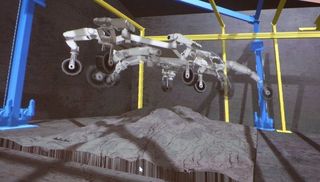NASA describe how Holodecks and spider robots will make us all Space Invaders

Only NASA would have the chutzpah to begin a GDC presentation with a 15-minute trailer about how great they are. But then, every game developer in the room grew up with the dreams of being an astronaut, watched the shuttles launch and felt sad when they were grounded forever, with replacements a distant hope. Among the developers in the room, there can't have been one who didn't dream of one day floating above our insignificant green-blue orb. And NASA were here to charm, flatter and promise them the moon. Because NASA needs the games industry.
NASA's promise is that, one day, we will all be taking part in “shared immersive tele-exploration” - or what the Trekkies out there will know as the Holodeck. That's how they're selling what they're doing. In reality, of course, budgets for space exploration have been gradually falling since 2009. As the slick Jeff Norris of the Jet Propulsion Laboratory told the conference, “We want to work with your industry and your vast resources.”
Some of this flattery is, of course, to do with the game industry's reach as a highly compelling widely-spread medium with particular youth appeal – as Norris said, 97% of American teenagers play video games. But more is to do with game developers' expertise in human interaction with devices and simulations. Norris praised particularly 2008's Sins of a Solar Empire; “I'm struck by the complexity of the interface, that you can walk up to, start using, and be ready in a couple of minutes.” He also admired Eve's interface, which still retains a usability curve. “Veritable civilisations are exploring fictional universes. How do we get those same people to start exploring the real universe?”

NASA is trying to get into games itself. There's Moonbase Alpha, a simulation developed by NASA to show us how a habitat on the moon would be built - which is sadly abused by autovoice spammers. There was a much-publicised Xbox 360 game that was launched to tie in with the Curiosity rover landing on Mars – and which was the subject of a formal congressional enquiry, with Senator Coburn calling the game the 18th most wasteful government project of 2012.
On the other side, they're experimenting with game controllers as control inputs for their robots. During the presentation, Norris's colleague Victor Luo (also of the Jet Propulsion Lab) demonstrated the remote control of a $5 million android using Kinect, whilst Norris did something even more impressive, remote controlling a 1-tonne, 15-foot, six-limbed spider robot in simulated zero-G using the hand-tracking Leap Motion Device, whilst his nervous colleagues stood by, their hands literally hovering over big red power-off buttons. The robot is the prototype for a 30-foot, 2-tonne model, which they're planning to send to the moon, mars and an asteroid.
And that's the ultimate aim of all this, as we mentioned at the beginning; the Holodeck. With tech like the Oculus Rift, and these super-sized drones and robots, configured for every environment, to explore the galaxy, NASA is confident that the holodeck will soon be a reality. As Norris put it, hyperbolically, “Everyone exploring the universe, stepping inside a holodeck, and standing on those distant worlds. Everyone gets to go. We can one moment be on the surface of Mars, then to the asteroid Vesta, joining the spaceship Dawn heading now to Ceres, then Cassini darting between Saturn and its moons, first being flown through a geyser at 70 miles per second then going to fly through the rings of Saturn... Look together on a world that even our most powerful telescopes have never seen. Search for life in the waters of Europa. 400 quadrillion stars, in a grain of sand held at arm's length.”
“Where are we going? Everywhere. You are the space invaders.”
The biggest gaming news, reviews and hardware deals
Keep up to date with the most important stories and the best deals, as picked by the PC Gamer team.
Most Popular








